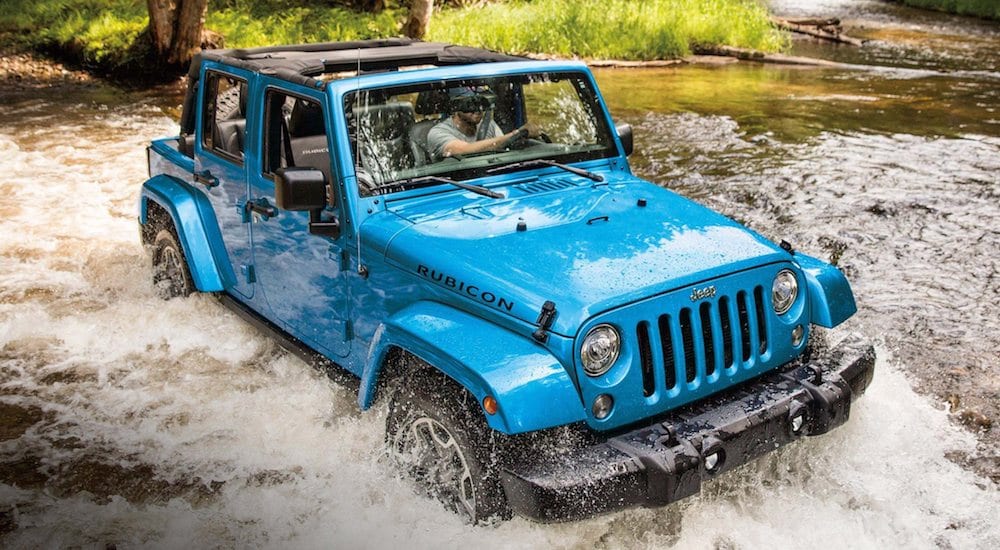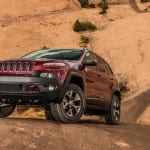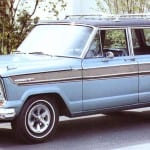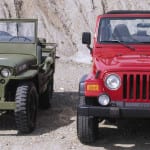If you’ve ever been looking for used cars in Colorado Springs and noticed the “Trail Rated” badge found on new and used Jeep vehicles then you’ve probably wondered what it means. And if not, then you’re going to find out the answer anyway. In some ways, the Trail Rated badge is a form of marketing meant to indicate that Jeep vehicles can handle some of the most intense and rough terrain found off the road. However, just because it is marketing doesn’t mean it lacks other value, as the badge is also a way for Jeep to brag about the durability and toughness of their vehicles.
While that little circle on their vehicles may be a way to show off, according to Jeep the badge is earned through rigorous testing in one of the toughest places in the country for a vehicle to traverse. I don’t blame them for wanting to show off what their 4×4 vehicles can do, and it certainly works as a way to set Jeeps apart from other all-terrain trucks and SUVs on the market. But I thought I’d take a closer look at what the badge means and how they choose to award it to their vehicles.
Earning the Badge
Let’s be clear: this is a badge that Jeep awards to its own vehicles, so this isn’t a major industry prize offered by a third-party that only Jeep manages to achieve. That being said, they don’t just slap it onto their vehicles and call it a day – at least according to their own information. They claim that their vehicles have to earn the Trail Rated badge through a series of tests that must be passed by any model that is given the badge before it enters the market.
These tests are designed to showcase the off-road capabilities of Jeep vehicles and push them to their limits. Any new or used Jeeps should be able to pass these same tests, as long as they are properly maintained and in good condition. There’s a reason Jeeps are well known as go-to vehicles for fans of off-roading and exploring rigorous and difficult trails. Over the years, Jeep has really embraced this image and lifestyle, and they created things like the Trail Rated badge to encourage their fans to keep pushing the limits of their vehicles.
The Five Tests
The following are the five test categories that each model must successfully pass to Jeep’s standard before receiving the Trail Rated badge. Exact specifications in most of these categories are not widely available, but we’ll assume they are at least as impressive as what similar vehicles can accomplish. At the very least, the area where the tests are performed is certainly gorgeous.
1. Traction
First and foremost in the Trail Rated testing comes traction since most off-road driving would be impossible without excellent traction. Trail Rated vehicles are designed to be able to handle unpredictable and harsh terrain with relative ease. This includes all kinds of weather, including rain and snow that can create muddy and icy conditions easily making the ground soggy and soft, as well as hard and frozen.
Of course, the tires on a Jeep will also directly impact how well it handles. Jeep no doubt tests their vehicles with the best tires on the market in excellent condition before tackling the harsh terrain. Let that be a reminder to always make sure the tires on your vehicle are in good shape before driving in hazardous conditions or hitting a tough trail.
2. Water Fording
One of the biggest challenges for many vehicles, especially those that might not be ideal for off-road driving, is fording water. New and used Jeeps with the Trail Rated badge are tested in different depths of water to ensure they can pass through without flooding electrical systems and intakes that can stall other vehicles. During manufacturing, the electrical connections and openings on Jeeps are sealed, while air intakes are positioned high up to allow for optimal water fording ability.
Exactly how deep a Jeep can manage to pass through depends on the model. In general, however, they are tested to be able to handle at least 19 inches of water, with some going as high as 30 inches of water fording without failing.
3. Maneuverability
Driving on challenging trails often requires excellent maneuverability, especially on those with dangerous and treacherous switchbacks. On some mountain trails, a single wrong move coming around a bend, or inability to handle a sharp turn, could leave a driver in a very dangerous position – or even send a vehicle plummeting hundreds of feet down a sheer cliff. Jeeps that are given the Trail Ready badge are tested for their ability to avoid obstacles on a trail, dodge gaps, and navigate through rough terrain.
4. Articulation
Articulation might be something the average driver doesn’t really think about, but a Jeep-lover with a need to hit the trail certainly keeps it in mind. High articulation allows the suspension on a vehicle to adjust and shift with optimal flexibility, to keep tires on the ground and move over obstacles. Poor articulation can leave a driver stranded as tires end up suspended in mid-air, or cause damage to the underside of a vehicle when the suspension cannot flex over rough terrain.
This level of articulation can also be useful for city driving, especially in areas where roads are dug up or damaged due to construction or rough winters. Potholes left behind by snow plows can seriously damage the tires and suspensions of many vehicles. A new or used Jeep with high levels of articulation can handle these kinds of hazards with minimal difficulty and prevent damage to the vehicle.
5. Ground Clearance
Although this goes hand-in-hand with criteria like water fording and articulation, a high ground clearance is also vital for shifts up or down in elevation while driving. It’s one thing to have traction and tires that can climb up a log or small boulder in the trail, but it’s another thing to have the ground clearance to do that without scraping up the underside of your truck. Jeeps that are Trail Rated are designed to keep the underbelly safely above the most hazardous of obstacles.
Exact ground clearance numbers can vary from one model to another, however, so always be sure to look at the specs of your particular vehicle to see what it can successfully clear. While driving, if you are unsure about clearance, whenever possible avoid going up or over an obstacle to protect your car or truck from serious damage.
The Rubicon Trail, California
The rigorous testing before awarding a Jeep with the Trail Rated badge isn’t conducted just anywhere. Jeep takes their vehicles out onto the famous Rubicon Trail in the Sierra Nevada Mountains of California. The trail is 22 miles long and offers some of the most intense, rocky terrain of any trail in the country. The Rubicon is well known among fans of off-road driving as one of the most beautiful trails anywhere and marks some of the roughest paths a truck or SUV can conquer.
The region was carved out by glaciers millions of years ago, leaving massive rocks and boulders behind which makes passage through The Rubicon quite daunting. The weather each year takes its toll on the trail, changing its shape and altering the terrain. This makes the testing conditions new each time Jeep takes a vehicle out on the trail, and encourages their designers to always push the envelope when it comes to trail-ready features.
While you may not be looking for a vehicle that can tackle the Rubicon Trail you may still need something that can traverse rough terrain in your neck of the woods. When looking for used cars in Colorado Springs you can certainly count on a Trail Rated Jeep to get you where you’re going.




